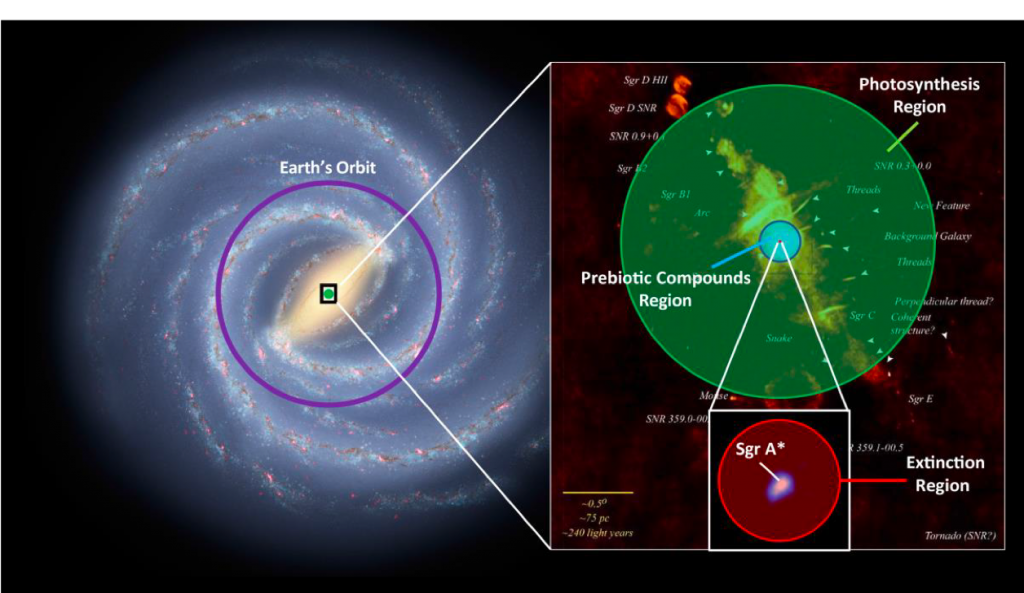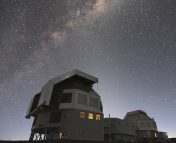
Lynnie Saade is an astronomy & astrophysics PhD student at the University of California, Los Angeles, where she uses X-rays to better understand active galactic nuclei. In her spare time she likes to write stories and draw comics where all or most of the characters are sentient natural phenomena. She hopes to be one of the first people to publish something where a supermassive black hole is a major character, just as they are major players on the stage of galaxy evolution.
Title: Active Galactic Nuclei: Boon or Bane for Biota?
Authors: Manasvi Lingam, Idan Ginsburg, and Shmuel Bialy
First Author’s Institution: Harvard University, Cambridge, MA
Status: Published in The Astrophysical Journal (open access)
When people think of supermassive black holes, they picture dragons of the cosmos, lording over the centers of their galaxy-sized hordes. Stars that enter their lairs are doomed to never return. With a single blast of their fiery breath, they can extinguish star formation, blow holes in the void between galaxies, and flay unlucky planets alive. When a supermassive black hole roars, everyone shudders…or so we imagine.
However, today’s paper suggests these dragons are more like the beneficent gods of Eastern myth than the monsters of Western lore. Far from bringing Armageddon, an actively feeding supermassive black hole, or active galactic nucleus (AGN), may be able to nurture life.
Fertile Fields (of Stars)
The precursors to life as we know it are organic compounds such as amino acids and nucleotides. Early in Earth’s history, a primordial soup of these prebiotic compounds underwent countless chains of chemical reactions that gradually led to the development of the first living thing. This process took only a hundred million years to occur—relatively brief on cosmic timescales.
One particular chemical pathway for producing these compounds relies on ultraviolet light. A planet bathed in the correct amount of this light would reap a bounty of organic molecules, ready to be slowly stirred into life. And it just so happens AGN spew out ultraviolet light in abundance.
It is likely that the Milky Way possessed an AGN at some point in the distant past, powered by its own supermassive black hole, Sgr A*. Considering the fraction of AGN radiation that is produced in the ultraviolet and the necessary flux for the chemical pathway to occur, the authors calculated that planets within 44 pc of the Galactic center (the blue circle in Figure 1) could have had their prebiotic compound abundances enhanced by an AGN.

Black Hole Sun, Won’t You Come…
The benefits Sgr A* could provide for the Milky Way’s life don’t stop at enhancing the abundances of prebiotic compounds. Even beyond 44 pc from the galactic center, where Sgr A*’s ultraviolet radiation would be too weak to form the precursors of life, the visible light levels would still be strong enough to power oxygen-generating photosynthesis. If the Milky Way gained an AGN, the authors calculate photosynthetic life could subsist on its light out to 340 pc away from the Galactic center (the green circle in Figure 1). This would enable photosynthesis to be performed not only on planets orbiting stars, but on free-floating planets without a host star. The typical lifetime for an AGN is around a hundred million to a billion years, which gives enough time for life to evolve on these rogue planets under the light of an AGN sun.
…Burn Down the Countryside?
While AGN radiation can provide benefits to life, in excess it would be detrimental. How detrimental it would be depends on how susceptible a planetary biosphere is to ultraviolet light.
Earth is protected from the highest energy ultraviolet light by its ozone layer. But what about planets without ozone layers? We know Earth lacked an ozone blanket for most of its history. Approximately 3.9 billion years ago, enough ultraviolet light hit the Earth’s surface to kill off even the most radiation-resistant organisms known today. Yet we know from chemical evidence that life was present on Earth at this time. This indicates microbial life can find ways to avoid ultraviolet light damage and adapt to the level of radiation from its host star.
Too drastic of an increase from this level, though, could spell trouble. The authors assume that life on a planet dies when it is bombarded with twice the ultraviolet light it normally receives from its sun. Applying this criterion, the authors find Earthlike planets would be sterilized only in the central 2 pc of the Milky Way (the red circle in Figure 1). It can clearly be seen that this region of sterilization is far smaller than Earth’s orbit, and smaller than even the regions of positive impacts on life. On balance, then, it would seem that an AGN would be a net positive for life in the Milky Way. The vast majority of the Galaxy would not be subjected to enough ultraviolet radiation to harm any life forms.
AGN also emit X-rays and gamma rays, though not quite as prodigiously as they emit ultraviolet light. The main risks posed by these rays to life would be stripping of the atmosphere and alteration of its chemistry. The authors do not attempt to model this but note that an active Sgr A* would bombard the Earth with X-ray levels a few orders of magnitude less than those received from big solar flares. It is therefore unlikely that AGN X-rays would pose major risks to most of the Galaxy.
Here Be Other Dragons
Based on the authors’ conclusions, an AGN in the Milky Way would have an impact on life in only a miniscule fraction of star systems. This is true even if we assume Sgr A* radiates as efficiently as the most luminous AGN, the quasars.
This would not be true for all galaxies, however, as different galaxies have differently sized supermassive black holes. In Figure 2 the distances out to which the positive and negative impacts can occur are shown as a function of black hole mass. More massive black holes can baste larger areas of space with their radiation, for good or ill. Life in an active galaxy with a very massive central black hole would face widespread impacts.
Nevertheless, the regions of beneficial impacts (blue and green shaded regions in Figure 2) are always larger than the regions of negative impacts (red shaded region in Figure 2), even in the galaxies with the most ponderous holes.
Supermassive black holes have a reputation as monsters, and it is in some ways well-deserved. Yet while the ancient titans and monsters of myth brought ruin, they also made the world as we know it. How fitting then would it be that giant black holes were not simply relics of an earlier, more ferocious age, but the stage-setters for life itself.

Astrobite edited by Jenny Calahan
Featured Image Credit: Kagoshima University




